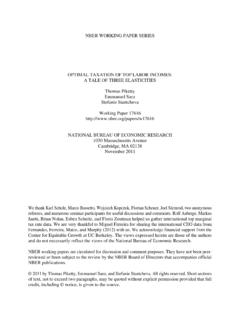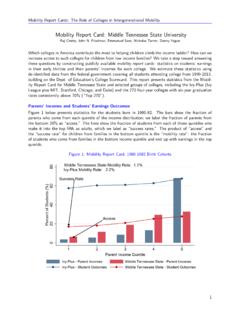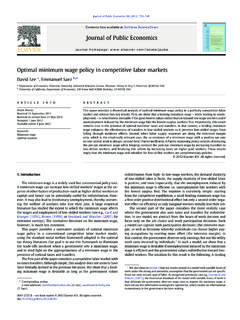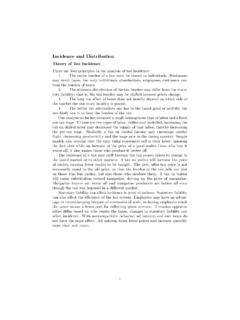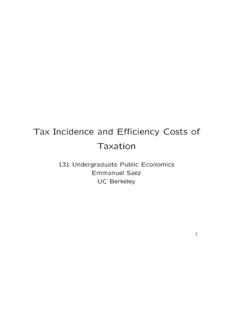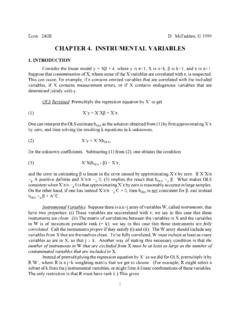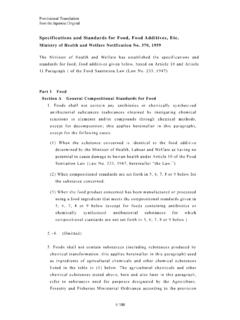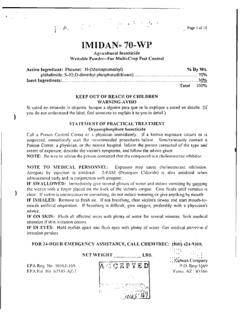Transcription of Great Depression - University of California, Berkeley
1 Forthcoming in the Encyclop dia Britannica Christina D. Romer December 20, 2003 Great Depression worldwide economic downturn that began in 1929 and lasted until about 1939. It was the longest and most severe Depression ever experienced by the industrialized Western world. Although the Depression originated in the United States, it resulted in drastic declines in output, severe unemployment, and acute deflation in almost every country of the globe. But its social and cultural effects were no less staggering, especially in the United States, where the Great Depression ranks second only to the Civil War as the gravest crisis in American history. Economic history The timing and severity of the Great Depression varied substantially across countries. The Depression was particularly long and severe in the United States and Europe; it was milder in Japan and much of Latin America. Perhaps not surprisingly, the worst Depression ever experienced stemmed from a multitude of causes.
2 Declines in consumer demand, financial panics, and misguided government policies caused economic output to fall in the United States. The gold standard, which linked nearly all the countries of the world in a network of fixed currency exchange rates, played a key role in transmitting the American downturn to other countries. The recovery from the Great Depression was spurred largely by the abandonment of the gold standard and the ensuing monetary expansion. The Great Depression brought about fundamental changes in economic institutions, macroeconomic policy, and economic theory. Timing and severity In the United States, the Great Depression began in the summer of 1929. The downturn became markedly worse in late 1929 and continued until early 1933. Real output and prices fell precipitously. Between the peak and the trough of the downturn, industrial production in the United States declined 47 percent and real GDP fell 30 percent.
3 The wholesale price index declined 33 percent (such declines in the price level are referred to as deflation ). Although there is some debate about the reliability of the statistics, it is widely agreed that the unemployment rate exceeded 20 percent at its highest point. The severity of these declines becomes especially clear when they are compared with America s next worst recession of the 20th century, that of 1981 82, when real GDP declined just 2 percent and the unemployment rate peaked at under 10 percent. Moreover, during the 1981 82 recession prices continued to rise, although the rate of price increase slowed substantially (a phenomenon known as disinflation ). The timing and severity of the Great Depression varied substantially across countries. Table 1 shows the dates of the downturn and upturn in economic activity in a number of countries.
4 Table 2 shows the peak-to-trough percentage decline in annual industrial production for countries for which such data are available. Great Britain struggled with low growth and recession during most of the second half of the 1920s, due largely to its decision in 1925 to return to the gold standard with an overvalued pound. Britain did not slip into severe Depression , however, until early 1930, and the peak-to-trough decline in industrial production was roughly one-third that of the United States. France also experienced a relatively short downturn in the early 1930s. The French recovery in 1932 and 1933, however, was short-lived. French industrial production and prices both fell substantially between 1933 and 1936. Germany s economy slipped into a downturn early in 1928 and then stabilized before turning down again in the third quarter of 1929. The decline in German industrial production was roughly equal to that in the United States.
5 A number of countries in Latin America slipped into Depression in late 1928 and early 1929, slightly before the decline in output. While some less developed countries experienced severe depressions, others, such as Argentina and Brazil, experienced comparatively mild downturns. The Depression in Japan started relatively late (in early 1930) and was, by comparison, mild. The general price deflation evident in the United States was also present in other countries. Virtually every industrialized country endured declines in wholesale prices of 30 percent or more between 1929 and 1933. Because of the greater flexibility of the japanese price structure, deflation in Japan was unusually rapid in 1930 and 1931. This rapid deflation may have helped to keep the decline in japanese production relatively mild. The prices of primary commodities traded in world markets declined even more dramatically during this period.
6 For example, the prices of coffee, cotton, silk, and rubber were reduced by roughly half just between September 1929 and December 1930. As a result, the terms of trade declined precipitously for producers of primary commodities. The recovery began in the spring of 1933. Output grew rapidly in the mid-1930s: real GDP rose at an average rate of 9 percent per year between 1933 and 1937. Output had fallen so deeply in the early years of the 1930s, however, that it remained substantially below its long-run trend level throughout this period. In 1937 38 the United States suffered another severe downturn, but after mid-1938 the American economy grew even more rapidly than in the mid-1930s. output finally returned to its long-run trend level in 1942. Recovery in the rest of the world varied greatly. The British economy stopped declining soon after Britain s abandonment of the gold standard in September 1931, though genuine recovery did not begin until the end of 1932.
7 The economies of a number of Latin American countries began to strengthen in late 1931 and early 1932. Germany and Japan both began to recover in the fall of 1932. Canada and many smaller European countries started to revive at about the same time as the United States, early in 1933. On the other hand, France, which experienced severe Depression later than most countries, did not firmly enter the recovery phase until 1938. Causes of the Great Depression The fundamental cause of the Great Depression in the United States was a decline in spending (sometimes referred to as aggregate demand), which led to a decline in production as manufacturers and merchandisers noticed an unintended rise in inventories. The sources of the contraction in spending in the United States varied over the course of the Depression , but they cumulated into a monumental decline in aggregate demand.
8 The American decline was transmitted to the rest of the world largely through the gold standard. However, a variety of other factors also influenced the downturn in various countries. Stock market crash The initial decline in output in the United States in the summer of 1929 is widely believed to have stemmed from tight monetary policy aimed at limiting stock market speculation. The 1920s had been a prosperous decade, but not an exceptional boom period; wholesale goods prices had remained nearly constant throughout the decade and there had been mild recessions in both 1924 and 1927. The one obvious area of excess was the stock market. Stock prices had risen more than fourfold from the low in 1921 to the peak reached in 1929. In 1928 and 1929, the Federal Reserve had raised interest rates in hopes of slowing the rapid rise in stock prices. These higher interest rates depressed interest-sensitive spending in areas such as construction and automobile purchases, which in turn reduced production.
9 Some scholars believe that a boom in housing construction in the mid-1920s led to an excess supply of housing and a particularly large drop in construction in 1928 and 1929. By the fall of 1929, stock prices had reached levels that could not be justified by reasonable anticipations of future earnings. As a result, when a variety of minor events led to gradual price declines in October 1929, investors lost confidence and the stock market bubble burst. Panic selling began on Black Thursday, October 24, 1929. Many stocks had been purchased on margin, that is, using loans secured by only a small fraction of the stocks value. As a result, the price declines forced some investors to liquidate their holdings, thus exacerbating the fall in prices. Between their peak in September and their low in November, stock prices (measured using the Cowles Index) declined 33 percent.
10 Because the decline was so dramatic, this event is often referred to as the Great Crash of 1929. The stock market crash reduced American aggregate demand substantially. Consumer purchases of durable goods and business investment fell sharply after the crash. A likely explanation is that the financial crisis generated considerable uncertainty about future income, which in turn led consumers and firms to put off purchases of durable goods. Although the loss of wealth caused by the decline in stock prices was relatively small, the crash may also have depressed spending by making people feel poorer. As a result of the drastic decline in consumer and firm spending, real output in the United States, which had been declining slowly up to this point, fell rapidly in late 1929 and throughout 1930. Thus, while the Great Crash of the stock market and the Great Depression are two quite separate events, the decline in stock prices was one factor causing the decline in production and employment in the United States.

